- Clone
- 5C2 (See other available formats)
- Regulatory Status
- RUO
- Other Names
- Fragile X mental retardation protein 1, POF, FMRP, POF1, FRAXA
- Previously
-
Covance Catalog# MMS-5232
- Isotype
- Mouse IgG1, κ
- Ave. Rating
- Submit a Review
- Product Citations
- publications

-

Human brain or whole cell extracts (15 µg total protein) from the indicated cells were resolved by 4-12% Bis-Tris gel electrophoresis, transferred to a PVDF membrane, and probed with 1.0 μg/mL (1:1000 dilution) purified anti-FMRP antibody (clone 5C2) overnight at 4°C. Proteins were visualized by chemiluminescence detection using HRP goat anti-mouse IgG antibody (Cat. No. 405306) at a 1:3000 dilution. Direct-Blot™ HRP anti-β-actin antibody (Cat. No. 664804) was used as a loading control at a 1:25000 dilution (lower). Lane M: Molecular weight marker. -

Western blot of purified anti-FMRP antibody (clone 5C2). Lane 1: Molecular weight marker; Lane 2: 20 µg of human brain lysate; Lane 3: 20 µg of mouse brain lysate. The blot was incubated with 1 µg/mL of the primary antibody overnight at 4°C, followed by incubation with HRP labeled goat anti-mouse IgG (Cat. No. 405306). Enhanced chemiluminescence was used as the detection system. -

ICC staining of purified anti-FMRP antibody (clone 5C2) on HeLa cells. The cells were fixed with 4% PFA, permeabilized with a buffer containing 0.1% Triton X-100 and 0.25% BSA, and blocked with 2% normal goat serum and 0.02% BSA. The cells were then incubated with 5 µg/ml of the primary antibody overnight at 4°C, followed by incubation wit 5 µg/ml of Alexa Fluor® 488 goat anti-mouse IgG for one hour at room temperature. Nuclei were counterstained with DAPI, and the slides were mounted with ProLongTM Gold Antifade Mountant. The image was captured with a 40X objective. Scale bar: 50 µm -

IHC staining of purified anti-FMRP antibody (clone 5C2) on formalin-fixed paraffin-embedded mouse brain tissue. Following antigen retrieval using Sodium Citrate H.I.E.R., the tissue was incubated with 10 µg/ml of the primary antibody overnight at 4°C, followed by incubation with Alexa Fluor® 488 goat anti-mouse IgG for two hours at room temperature. Nuclei were counterstained with DAPI, and the slides were mounted with ProLongTM Gold Antifade Mountant. The image was captured with a 40X objective. Scale Bar: 50 µm -

IHC staining of purified anti-FMRP antibody (clone 5C2) on formalin-fixed paraffin-embedded mouse brain tissue. Following antigen retrieval using Sodium Citrate H.I.E.R., the tissue was incubated with 10 µg/ml of the primary antibody overnight at 4°C, followed by incubation with Alexa Fluor® 488 goat anti-mouse IgG for two hours at room temperature. Nuclei were counterstained with DAPI, and the slides were mounted with ProLongTM Gold Antifade Mountant. The image was captured with a 40X objective. Scale Bar: 50 µm -

Reactivity of 5C2 to cell lysates of lymphoblastoid cell lines derived from normal (C) and male FX full mutation (FM) individuals @ 1:2000 dilution. The absence of a band in the FX full mutation lane shows the protein is not present in fragile X individuals but is present in normal subjects. (Courtesy of R. Kascsak)
| Cat # | Size | Price | Quantity Check Availability | Save | ||
|---|---|---|---|---|---|---|
| 834702 | 25 µL | £73 | ||||
| 834701 | 100 µL | £189 | ||||
The gene encoding Fragile X mental retardation protein 1 (FMRP or FMR1), also known as premature ovarian failure 1 (POF1), contains multiple CGG sequence repeats that are positively correlated with impaired cognitive and reproductive function. FMRP may be involved in mRNA transport and synaptic protein synthesis. The gene that encodes FMRP is located in the X chromosome, and an abnormally large number of CGG repeats (200 - 1000 times) causes Fragile X syndrome due to inadequate amounts of FMRP, leading to severe learning deficiency and mental retardation.
Product DetailsProduct Details
- Verified Reactivity
- Human, Mouse
- Antibody Type
- Monoclonal
- Host Species
- Mouse
- Immunogen
- This monoclonal antibody was raised against a recombinant protein isolated from baculovirus expressing mouse FMRP.
- Formulation
- Phosphate-buffered solution.
- Preparation
- The antibody was purified by affinity chromatography.
- Concentration
- 1 mg/ml
- Storage & Handling
- This antibody should be handled aseptically as it is free of preservatives such as Sodium Azide. Store this antibody undiluted between 2°C and 8°C. Please note the storage condition for this antibody has been changed from -20°C to between 2°C and 8°C. You can also check the vial label or CoA to find the proper storage conditions.
- Application
-
WB - Quality tested
ICC, IHC-P - Verified - Recommended Usage
-
Each lot of this antibody is quality control tested by Western blotting. For Western blotting, the suggested use of this reagent is 1.0 - 2.0 µg per ml. For immunohistochemistry on formalin-fixed paraffin-embedded tissue, a concentration range of 5.0 - 10 µg/ml is suggested. For immunocytochemistry, a concentration range of 5.0 - 10 μg/ml is recommended. It is recommended that the reagent be titrated for optimal performance for each application.
- Application Notes
-
This antibody is effective in immunoblotting (WB), immunohistochemistry on formalin-fixed paraffin-embedded tissue (IHC-P) and immunocytochemistry (ICC).
The epitope for 5C2 lies between amino acids 347-353 of FMRP. This clone does not cross react with FXR1 or FXR2. -
Application References
(PubMed link indicates BioLegend citation) -
- Gholizadeh S, et al. 2014. Neuropsychopharmacology. 39:3100.
- Product Citations
-
- RRID
-
AB_2564993 (BioLegend Cat. No. 834702)
AB_2564993 (BioLegend Cat. No. 834701)
Antigen Details
- Structure
- Expected MW: 68-80 kD (smaller truncations of FMRP seen at lower molecular weights)
- Biology Area
- Cell Biology, Neuroscience, Synaptic Biology, Transcription Factors
- Molecular Family
- Postsynaptic proteins, Presynaptic proteins
- Gene ID
- 2332 View all products for this Gene ID
- UniProt
- View information about FMRP on UniProt.org
Related Pages & Pathways
Pages
Other Formats
View All FMRP Reagents Request Custom Conjugation| Description | Clone | Applications |
|---|---|---|
| Purified anti-FMRP | 5C2 | WB,IHC-P,ICC |
Customers Also Purchased
Compare Data Across All Formats
This data display is provided for general comparisons between formats.
Your actual data may vary due to variations in samples, target cells, instruments and their settings, staining conditions, and other factors.
If you need assistance with selecting the best format contact our expert technical support team.
-
Purified anti-FMRP
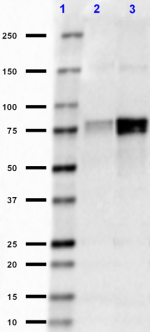
Western blot of purified anti-FMRP antibody (clone 5C2). Lan... 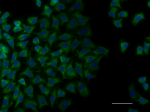
ICC staining of purified anti-FMRP antibody (clone 5C2) on H... 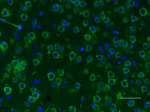
IHC staining of purified anti-FMRP antibody (clone 5C2) on f... 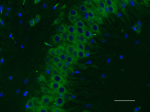
IHC staining of purified anti-FMRP antibody (clone 5C2) on f... 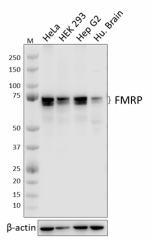
Human brain or whole cell extracts (15 µg total protein) fro... 
Reactivity of 5C2 to cell lysates of lymphoblastoid cell li...
 Login / Register
Login / Register 












Follow Us